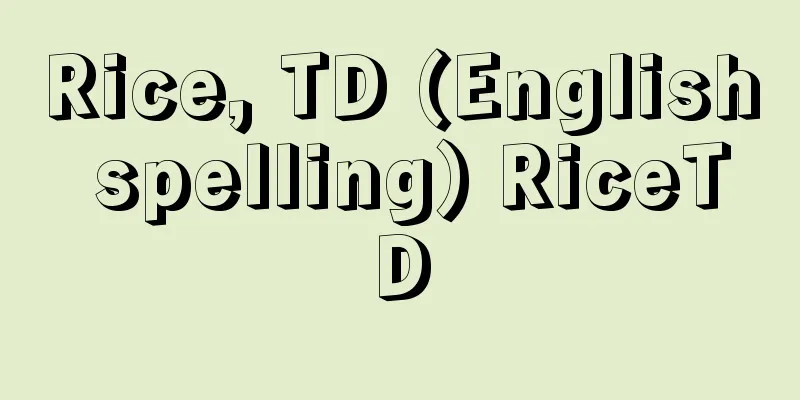Yucca - Yucca

|
A general term for plants of the Agavaceae family (APG classification: Asparagaceae) and the genus Agava. It grows in semi-desert areas and is characterized by its woody stems and fleshy leaves, which led to it being classified as a new family from the traditional Liliaceae family. There are about 30 species in southern North America, Mexico, the West Indies, etc. It is an evergreen woody plant, but some have almost no stems. The leaves grow in clusters at the terminal end of the stem, or on the roots. They are linear or sword-shaped, fleshy and tough, with some having prickly tips, while others have serrated or thread-like fibers on the edges. A large panicle inflorescence stands upright from the leaf center, and many large, bell-shaped white flowers open downward. It has six perianths and one pistil, and in its native habitat it bears a capsule. Some were introduced to Japan from the end of the Edo period to the Meiji period. In addition to Y. gloriosa L., Y. gloriosa var. tristis Carrière ( Y. recurvifolia Salisb.), and Y. filamentosa L., which are native to southern North America, Y. aloifolia L., which is native to southern North America and the West Indies, and the yellow-edged horticultural variety Kinpo-ran, are planted as ornamental plants in parks and gardens in warm areas west of the Kanto region of Honshu. They grow well in sunny areas, can tolerate dryness, and are not picky about soil type. They are resistant to urban pollution and are easy to transplant. They are propagated by cuttings and root division. [Yoshio Kobayashi May 21, 2019] Cultural historyIn prehistoric times, flowers were a source of food for North American Indians. Numerous coprolites found in rock shelter ruins in southwest Texas contained yucca pollen. Some coprolites contained over 90% yucca pollen, revealing that people gathered during the yucca flowering season and ate the flowers. The oldest coprolite dates back 2,800 years. Yucca was once used as animal feed and to obtain fiber, but its use today is almost exclusively limited to ornamental cultivation. The first yucca was introduced to Europe in 1596. The yucca was introduced to Japan via the Netherlands at the end of the Edo period, but it is said that it did not spread until after the Great Kanto Earthquake (1923), due to the increase in Western-style gardens and buildings. [Hiroshi Yuasa May 21, 2019] [Reference] | |In May to June and October, large panicles grow upright and produce numerous yellow-white bell-shaped flowers. They are often planted in gardens and parks . Kimigayoran The sword-shaped leaves are leathery and have sharp tips. A panicle inflorescence is produced at the end of the flower stalk, which curves slightly and hangs down. It is planted in parks and gardens in warm areas west of the Kanto region . Senjuran Source: Shogakukan Encyclopedia Nipponica About Encyclopedia Nipponica Information | Legend |
|
リュウゼツラン科(APG分類:キジカクシ科)イトラン属植物の総称。半砂漠地に生え、木質の茎と多肉質の葉をもつ特徴があり、従来のユリ科から新しい科に変わった。北アメリカの南部、メキシコ、西インド諸島などに約30種ある。常緑木質植物であるが、茎がほとんどないものもある。葉は茎に頂生して多数集まるか、または根生する。線形または剣状で、肉質で堅く、先は刺(とげ)となるもの、縁(へり)に鋸歯(きょし)または糸状の繊維がつくものがある。葉心から大形の円錐(えんすい)花序を直立して、鐘形の大きい白色花を多数下向きに開く。花被片(かひへん)は6枚、雌しべは1本で、原産地では蒴果(さくか)を結ぶ。日本には江戸時代の末から明治年間に一部が渡来した。北アメリカ南部原産のアツバキミガヨラン(厚葉君代蘭)Y. gloriosa L.、キミガヨラン(君代蘭)Y. gloriosa var. tristis Carrière (Y. recurvifolia Salisb.)、イトラン(糸蘭)Y. filamentosa L.のほかに、北アメリカ南部から西インド諸島原産のセンジュランY. aloifolia L.、葉辺が黄色の園芸品種キンポウランなどが、本州の関東地方以西の暖地の公園や庭園に観賞用として植えられている。日当りでよく育ち、乾燥に耐え、土質を選ばない。都市の公害にも強く、移植は容易。繁殖は挿木、根分けによる。 [小林義雄 2019年5月21日] 文化史先史時代、北アメリカのインディアンにとって、花は食料の一つであった。南西テキサスの岩陰遺跡からみつかった多数の糞石(ふんせき)に、ユッカの花粉が含まれていた。なかには花粉の90%以上をユッカが占める糞石もあり、ユッカの花期に集まり、花を食べる食生活のあったことが明らかにされた。そのもっとも古い糞石は2800年前にさかのぼる。ユッカはかつて飼料にされ繊維も得たが、現在の利用は観賞栽培にほぼ限られる。ヨーロッパには、1596年に初めてアツバキミガヨランが伝わった。日本には幕末に、オランダ経由でイトランが渡来したが、広がるのは関東大震災(1923)以後で、洋式庭園と洋館が増えたからといわれる。 [湯浅浩史 2019年5月21日] [参照項目] | |5~6月と10月ごろ、大きな円錐花序を直立して、黄白色の鐘形花を多数開く。庭園や公園によく植栽される©Shogakukan"> キミガヨラン 剣状の葉は革質で、先端が鋭くとがる。花茎の先に円錐花序をつけ、先がやや湾曲して下垂する。関東以西の暖地の公園や庭園に植栽される©Shogakukan 撮影/広瀬雅敏"> センジュラン 出典 小学館 日本大百科全書(ニッポニカ)日本大百科全書(ニッポニカ)について 情報 | 凡例 |
Recommend
spoils system
Also known as the spoils system, it is a political...
Terminalia catappa L.
A semi-deciduous tall tree of the Combretaceae fam...
Wilson, JT
...This cycle applies not only to the past 200 mi...
Gaussian number field
…This is called the number theory of algebraic nu...
Infinity - Mujin
One of the mutual aid systems in Japan. A certain ...
Evgeniy Aleksandrovich Evtushenko
Russian poet, novelist, and film director. Born i...
Shigetou Isen
...A 1932 production by Kataoka Chiezo Production...
premium era
…These myths and legends led the Greeks to regard...
Karukaya
The title of a sekkyobushi (a traditional Japanese...
Wochenmarkt
… The cities that were established in Western Eur...
Frederick [II] - Friedrich
King of Prussia (reigned 1740-1786). Son of Freder...
Utility model - utility model (English spelling)
It is a synonym for the device used in the Utilit...
Public affairs land - Kuujijoden
...In other words, the eldest son system had the ...
Worpswede (English spelling)
A village in Lower Saxony, northern Germany, locat...
beam antenna
…One-wave dipole antennas, which have the effect ...









